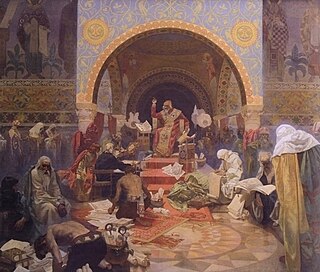
The Battle of Adrianople occurred around Adrianople on April 14, 1205 between Bulgarians, Vlachs and Cumans under Tsar Kaloyan of Bulgaria, and Crusaders under Baldwin I, who only months before had been crowned Emperor of Constantinople, allied with Venetians under Doge Enrico Dandolo. It was won by the Bulgarians, after a successful ambush.

Theodoros I Komnenos Laskaris was the first Emperor of Nicaea.

Baldwin I was the first emperor of the Latin Empire of Constantinople. As Count of Flanders and Hainaut, he was one of the most prominent leaders of the Fourth Crusade, which resulted in the sack of Constantinople and the conquest of large parts of the Byzantine Empire, and the foundation of the Latin Empire. He lost his final battle to Kaloyan, the emperor of Bulgaria, and spent his last days as his prisoner.

Henry was the second emperor of the Latin Empire of Constantinople. He was a younger son of Baldwin V, Count of Hainaut, and Margaret I of Flanders, sister of Philip of Alsace, count of Flanders.
Theodore Branas or Vranas, sometimes called Theodore Komnenos Branas, was a general under the Byzantine Empire and afterwards under the Latin Empire of Constantinople. Under the Latin regime he was given the title Caesar and in 1206 he became governor and lord of Adrianople. He is called Livernas by western chroniclers of the Fourth Crusade, including Geoffroi de Villehardouin.

The Kingdom of Thessalonica was a short-lived Crusader State founded after the Fourth Crusade over conquered Byzantine lands in Macedonia and Thessaly.

Louis I of Blois was Count of Blois from 1191 to 1205. He was the son of Theobald V and Alix of France. His maternal grandparents were Louis VII of France and his first wife, Eleanor of Aquitaine. Whilst in his teens, Louis joined his father on the Third Crusade.
The Bulgarian–Latin wars were a series of conflicts between the Second Bulgarian Empire (1185–1396) and the Latin Empire (1204–61). The wars affected the northern border of the Latin Empire throughout its existence.

Othon de la Roche, also Otho de la Roche, was a Burgundian nobleman of the De la Roche family from La Roche-sur-l'Ognon. He joined the Fourth Crusade and became the first Frankish Lord of Athens in 1204. In addition to Athens, he acquired Thebes by around 1211.

The Battle of Philippopolis or Battle of Plovdiv took place on 30 June 1208 in the surroundings of Philippopolis between the armies of the Bulgarian Empire and the Latin Empire. The Crusaders were victorious.
The battle of Serres took place in June 1205 in the town of Serres (Syar) in contemporary Greece between the Bulgarian Empire and the Latin Empire. It resulted in a Bulgarian victory.
The Duchy of Philippopolis was a short-lived duchy of the Latin Empire founded after the collapse and partition of the Byzantine Empire by the Fourth Crusade in 1204. It included the city of Philippopolis and the surrounding region.
The Lordship of Demotika was a short-lived Crusader state in 1204–05, founded after the Fourth Crusade in the conquered Byzantine lands of Thrace around Demotika (Didymoteicho).
Berthold II von Katzenelnbogen was a German nobleman of the family of the Counts of Katzenelnbogen and a participant in the Fourth Crusade (1202–04), who became lord of Velestino (c.1205–17) and regent of the Kingdom of Thessalonica (c.1217) in Frankish Greece. He was a patron of poets and in politics a Ghibelline.
Anseau IV de Cayeux was a French knight from Picardy, who participated in the Third Crusade alongside his kinsman William de Cayeux; survived to join the Fourth Crusade and became a leading noble and regent of the Latin Empire.
Eustace of Flanders or Eustace of Hainaut was a member of the House of Flanders, brother of the Latin Emperors Baldwin I and Henry, and regent of the Kingdom of Thessalonica in 1209–1216.
Garnier de Traînel was the bishop of Troyes from 1193 until his death. He took part in the Fourth Crusade (1202–04) and in the founding of the Latin Empire.


















